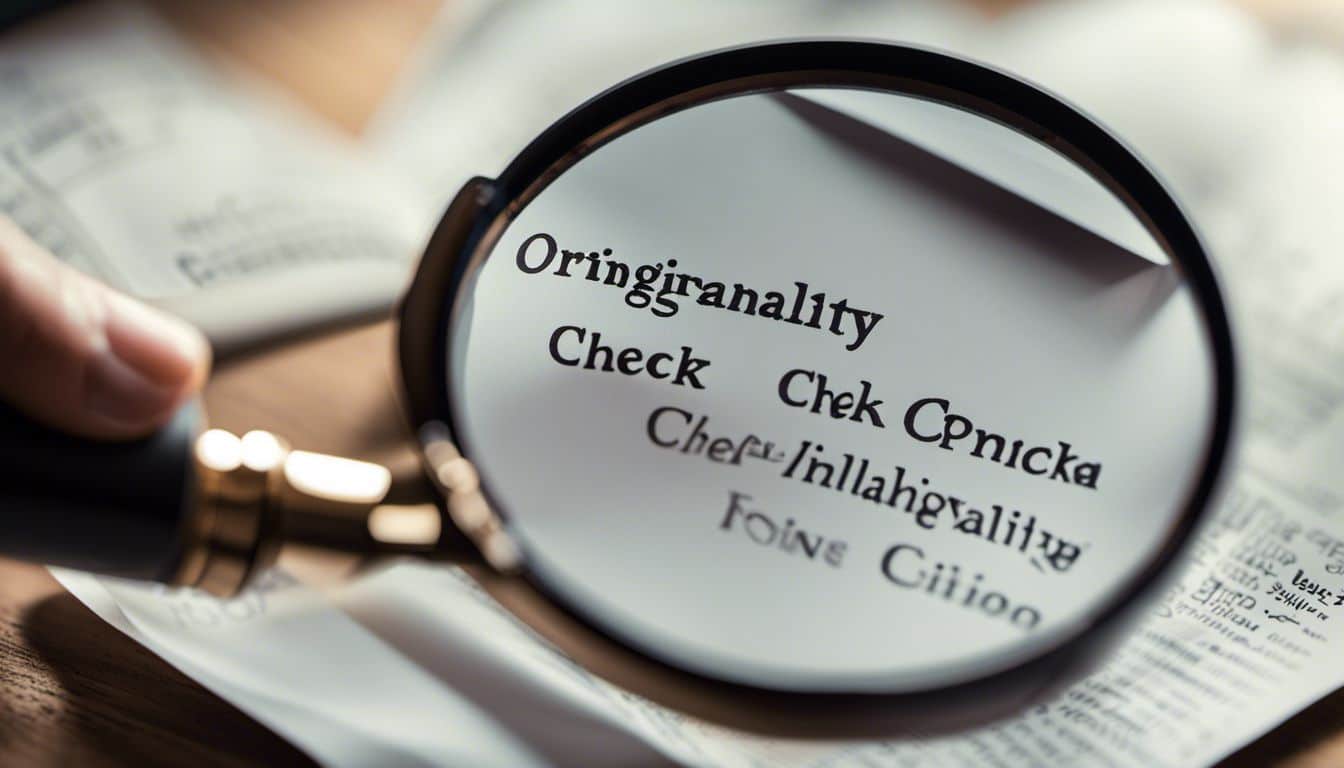Can Katteb Pass Turnitin Detection?
Are you curious if an AI content writer such as Katteb can evade Turnitin’s sophisticated plagiarism checker? You’re not alone, I’ve been there too. After intense research and tests, this blog post provides an in-depth analysis of how these AI Detection systems work.
Stay tuned for a fascinating reveal on the effectiveness of tools like Katteb against Turnitin’s detection abilities!
Key Takeaways
- Turnitin’s AI detection technology can identify similarities, patterns, and matches in text to detect plagiarism and AI-generated content.
- Students use strategies like paraphrasing, word order manipulation, mixing multiple sources, manual citation manipulation, and spintax tools to try and pass Turnitin detection.
- To increase the chances of passing Turnitin detection, students should use proper paraphrasing techniques, conduct thorough research for original content creation, and utilize plagiarism-checking tools before submitting their work.
How Turnitin AI Detection Works
Turnitin AI Detection works by analyzing and comparing submitted documents with a vast database of academic papers, online content, and previous student submissions to identify similarities and potential instances of plagiarism.
The process of detecting plagiarism and AI-generated content
Turnitin uses advanced algorithms to detect content generated through artificial intelligence. These mechanisms operate by scanning submitted documents and comparing them with an expansive database of academic texts, articles, and other online resources.
The software targets identical or near-identical phrasings that suggest plagiarism or AI writing. It also examines word choice patterns, syntax structure, punctuation usage, and other linguistic characteristics to spot artificially generated content.
Turnitin’s system is sophisticated but not foolproof; it can fail in the face of complex AI writing tools such as ChatGPT which have been designed to mimic human-like writing skills exceptionally well.
That being said, continual updates are made to enhance its efficiency against modern tech advancements like ChatGPT.
How Turnitin identifies similarities and matches
Turnitin’s AI detection technology is designed to identify similarities and matches in text. It operates by analyzing and comparing the content to a vast database of existing sources, academic journals, publications, and student papers.
Using advanced algorithms, Turnitin’s system can detect patterns and similarities in sentence structure, word choice, and overall writing style. By conducting comprehensive text similarity and citation analysis, Turnitin ensures that submitted work is original and does not infringe upon others’ intellectual property rights.
The aim of this technology is to promote academic integrity by discouraging plagiarism and helping educators maintain high standards of originality in student work.
Challenges in Passing Turnitin Detection
AI detectors face limitations in detecting sophisticated techniques, making it challenging for students to bypass Turnitin detection.
The limitations of AI detectors in detecting sophisticated techniques
AI detectors have greatly enhanced the ability to identify instances of plagiarism and AI-generated content. However, these detectors do have their limitations when it comes to detecting sophisticated techniques employed by students.
While they can effectively flag direct copying or verbatim text matches, they may struggle with more advanced methods such as paraphrasing, rephrasing, or using synonyms. This means that some AI-assisted writing could potentially go undetected if the student employs these complex strategies to bypass Turnitin’s AI detection system.
It is important for educators and institutions to be aware of these limitations and continuously update their detection methods to stay one step ahead of evolving cheating techniques.
Strategies used by students to try and pass Turnitin
As a tech columnist who has explored the world of AI-assisted writing and Turnitin detection, I have come across several strategies used by students to try and pass Turnitin. Here are some of the strategies that have been employed:
- Paraphrasing and synonym substitution: Students often rely on paraphrasing techniques to make their content appear original. They replace certain words with synonyms or rephrase sentences to avoid detection.
- Word order manipulation: Another tactic is rearranging the order of words in a sentence or altering sentence structure to make it look different from the original source.
- Mixing multiple sources: Some students combine information from multiple sources to create an illusion of originality. By blending ideas from various texts, they try to avoid direct matches.
- Manual citation manipulation: Students may change or remove citations altogether to make their work seem like their own creation. This involves manipulating references or removing them entirely.
- Using “spintax” tools: Spintax tools generate multiple versions of a text by replacing words with synonyms or reordering phrases. Students utilize these tools to create content that appears unique but still resembles the original source.
Tips to Pass Turnitin Detection
Utilize proper paraphrasing techniques, conduct thorough research, and use plagiarism-checking tools before submitting your work to increase the chances of passing Turnitin detection.
Proper paraphrasing and citation techniques
I have discovered some effective techniques for proper paraphrasing and citation that can help you pass Turnitin’s AI detection. These techniques include:
- Understanding the original source: Before attempting to paraphrase, make sure you fully comprehend the main ideas and concepts of the original text.
- Rewording without changing the meaning: Paraphrasing involves restating the information in your own words while maintaining the original meaning. Avoid using synonyms for every word; instead, focus on expressing the ideas in a unique way.
- Citing your sources correctly: Whenever you use someone else’s ideas or words, ensure you provide proper citations using the appropriate citation style (such as APA or MLA). This shows academic integrity and acknowledges the original author’s work.
- Quoting when necessary: If there are specific phrases or sentences that are difficult to rephrase without losing their impact, it’s acceptable to use direct quotes. Just be sure to enclose them in quotation marks and provide a citation.
- Checking for consistent formatting: Ensure that your citations and references follow a consistent format throughout your paper. This includes using the same style (e.g., parenthetical citations, footnotes) and providing complete bibliographic information.
- Using plagiarism-checking tools before submission: Take advantage of online tools like Grammarly or Turnitin’s own free plagiarism checker to scan your work before submitting it. These tools can help identify any potential issues with similarity or unoriginal content.
Thorough research and original content creation
When it comes to passing Turnitin detection, thorough research and original content creation are crucial. By conducting extensive research on a topic and incorporating unique ideas, you can ensure that your content is authentic and stands out from other sources.
This not only helps in avoiding plagiarism but also demonstrates your understanding of the subject matter. By taking the time to explore different perspectives, gather accurate information, and present your own analysis or insights, you can create original content that meets academic standards while evading detection by AI algorithms like Turnitin.
Using tools to check for plagiarism before submitting
I highly recommend using plagiarism checking tools before submitting any written work. These tools can help ensure that your content is original and does not contain any plagiarized material. Here are some tips on using these tools effectively:
- Choose a reliable plagiarism checker: There are many plagiarism checkers available online, but not all of them are accurate or trustworthy. Look for well-known and reputable tools that provide comprehensive plagiarism detection.
- Run multiple scans: Don’t rely on just one scan. Run your content through multiple plagiarism checkers to get a more accurate result. Each tool may have slightly different algorithms and databases, so this will help identify any potential issues.
- Understand the reports: Plagiarism checkers provide detailed reports highlighting any instances of copied content or similarities found in other sources. Take the time to understand these reports and make necessary revisions to your work.
- Correctly attribute sources: If you have used information or ideas from other sources, make sure to properly attribute them through citations and references. This shows academic honesty and reduces the chances of being flagged for plagiarism.
- Use paraphrasing techniques: When incorporating information from external sources, practice proper paraphrasing techniques to express the ideas in your own words while still giving credit to the original source.
- Be cautious with AI-generated content: If you are using AI writing tools, be aware of how they may affect the originality of your work. Some AI-generated content can still be flagged as plagiarized if it closely resembles existing materials.
Conclusion
In conclusion, while Turnitin’s AI detection technology has made significant strides in identifying AI-generated content, it is still challenging for Katteb or any other AI writer to pass the detection.
The limitations of AI detectors and the complexity of strategies used by students to deceive Turnitin pose significant obstacles. However, by employing proper paraphrasing techniques, conducting thorough research, and using plagiarism-checking tools before submitting work, individuals can increase their chances of evading detection.
Ultimately, maintaining academic integrity should be a priority rather than finding ways to cheat the system.
FAQs
1. Can Katteb pass Turnitin detection?
No, Katteb cannot pass Turnitin detection as it is a plagiarism detection software designed to identify similarities between submitted works and existing sources.
2. Is there any software that can guarantee passing Turnitin detection?
There is no software that can guarantee passing Turnitin detection as it is specifically designed to detect similarities in written content and accurately assess originality.
3. How does Turnitin work to detect plagiarism?
Turnitin uses a vast database of published works, internet sources, and student submissions to compare the text of a submitted document with existing content. It highlights matches or similar passages, providing an overall similarity score for the submitted work.
4. What happens if my submission is flagged by Turnitin?
If your submission is flagged by Turnitin, your instructor or institution will review the report generated by the system. They will assess whether any identified similarities are properly cited or represent instances of plagiarism that require further action according to their policies and guidelines.





